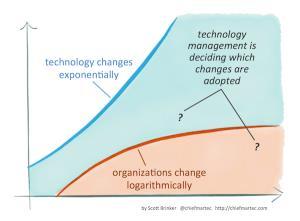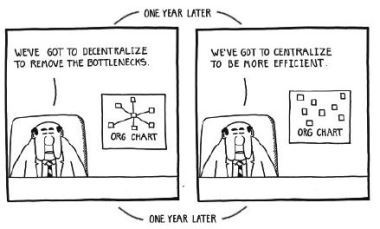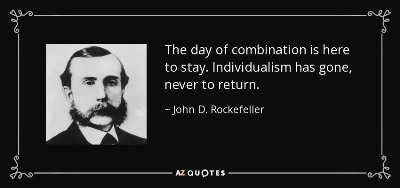Jeremie Averous's Blog, page 92
March 24, 2016
Why There is a Gap Between Technology and Organization Evolution
There is a gap between technology development and the way organization change. And this is at the root of the Fourth Revolution: if the gap gets large enough, only a revolution can make organizations evolve to fit with technology. And it is what is happening right now.
 I find the illustration by Scott Brinker the best – he call it the Martec’s law: “Technology changes exponentially; organizations change logarithmically“. He applies it to the current digital disruption, but of course it was always the case – the industrial revolution was also created by a progressive mismatch between technology and the institutions and organizations of the previous Age. Organizations can only change at a certain pace, and the larger they are, the slower they can evolve; they generally can’t cope with the increasing rate of technology evolution without undergoing a substantial change.
I find the illustration by Scott Brinker the best – he call it the Martec’s law: “Technology changes exponentially; organizations change logarithmically“. He applies it to the current digital disruption, but of course it was always the case – the industrial revolution was also created by a progressive mismatch between technology and the institutions and organizations of the previous Age. Organizations can only change at a certain pace, and the larger they are, the slower they can evolve; they generally can’t cope with the increasing rate of technology evolution without undergoing a substantial change.
According to this law, a revolution is inevitable that will rebaseline the organizational setup to the current state of technology development. And this will be highly disruptive to existing organizations – unless they find a way to overcome the curse of only being able to evolve slowly.

March 22, 2016
How Decentralized Organizations Can be Effective
“In the early 20th century, big companies were synonymous with efficiency. In the late 20th century they were synonymous with inefficiency.” writes Paul Graham in his post ‘Refragmentation‘.
 This is of course a bit simplified, however it fits with the historic trend of outsourcing and contracting a lot of the value chain out of the main industrial conglomerates into networks of suppliers and contractors, and the emergence of loose networks of small entities that prove to be more flexible and resilient than large organizations.
This is of course a bit simplified, however it fits with the historic trend of outsourcing and contracting a lot of the value chain out of the main industrial conglomerates into networks of suppliers and contractors, and the emergence of loose networks of small entities that prove to be more flexible and resilient than large organizations.
At the same time to be successful in large endeavors and projects, large organizations are still needed to leverage the appropriate financing and create the local conditions of low complexity and alignment that are necessary to make these endeavors successful.
It is difficult to combine the flexibility of networks of small, relatively independent entities with the coherence and leverage that are necessary for large endeavors. There is no fixed recipe, however that is probably quite the form of organization that will be the future in the Collaborative Age. We need to find the right approaches, and that is certainly one the challenges I encounter on a regular basis in my consulting activities.

March 19, 2016
How Individualism Returns after a Short Industrial Age Parenthesis
Paul Graham in his (controversial but thought provoking) post ‘Refragmentation‘ gives an interesting overall view of how the Industrial Age may have just been a short parenthesis in the history of humankind when it comes to lesser individualism and more even spread of wealth.
 How Rockefeller was wrong. Individualism only collapsed for the Industrial Age.
How Rockefeller was wrong. Individualism only collapsed for the Industrial Age.He states: “The late 19th and early 20th centuries had been a time of consolidation, led especially by J. P. Morgan. Thousands of companies run by their founders were merged into a couple hundred giant ones run by professional managers. Economies of scale ruled the day. It seemed to people at the time that this was the final state of things. John D. Rockefeller said in 1880: “The day of combination is here to stay. Individualism has gone, never to return“. He turned out to be mistaken, but he seemed right for the next hundred years.”
With the Fourth Revolution, large companies are not any more the most effective way of creating value. Individualism is enhanced by our capability to broadcast to the world, and the contribution of everyone is enhanced.
In many ways the Industrial Age was an exception to the way the world had been moving along, and it may have been a short exception in many ways regarding individual life, employment and our social contract.

March 17, 2016
Why You Should Constantly Develop the Leadership Capacity of Others
I stumbled on this excellent quote by Pamela Slim: “Your job is to build the leadership capacity of the community you serve.”
 Pamela Slim continues: “What does this mean? Your success as a leader, whether as an independent professional, a manager in an organization, a coach or a parent, depends on your ability to provide challenging learning experiences that make the people around you stronger, more capable and more prepared to solve the problems that you all care about. In short, stop doing things for them and start supporting them to do things for themselves.”
Pamela Slim continues: “What does this mean? Your success as a leader, whether as an independent professional, a manager in an organization, a coach or a parent, depends on your ability to provide challenging learning experiences that make the people around you stronger, more capable and more prepared to solve the problems that you all care about. In short, stop doing things for them and start supporting them to do things for themselves.”
Let’s pause for a moment here. I find this extremely insightful. Instead of teaching skills the conventional way, she states that we should mainly focused on developing other’ leadership capabilities. Quite a challenge, and this certainly challenges the conventional views. On the other hand it is quite right.
She concludes: “This is easier in theory than it is in practice.” Sure. When do we start?

March 15, 2016
Why We Should Reconsider The Reason We’re Doing Startups
In this refreshing post ‘Reconsider‘, David Hansson, the cofounder of Basecamp, exposes his philosophy of startups and why he considers the general view of looking for fast-growing, billion dollar valuation startups to be a general conspiracy.
 “Part of the problem seems to be that nobody these days is content to merely put their dent in the universe. No, they have to fucking own the universe. It’s not enough to be in the market, they have to dominate it. It’s not enough to serve customers, they have to capture them.”
“Part of the problem seems to be that nobody these days is content to merely put their dent in the universe. No, they have to fucking own the universe. It’s not enough to be in the market, they have to dominate it. It’s not enough to serve customers, they have to capture them.”
On the contrary, David explains his approach: “I wanted to work for myself. Walk to my own beat. Chart my own path. Call it like I saw it, and not worry about what dudes in suits thought of that.” He then declines it on several dimensions:
“I wanted to make a product and sell it directly to people who’d care about its quality.”
“I wanted to put down roots. Long term bonds with coworkers and customers and the product.”
“I wanted the best odds I could possibly get at attaining the tipping point of financial stability.”
“I wanted a life beyond work.”
I am personally rather on his small, human adventure side. What serves to develop a great venture that will eat me out? Let’s make a significant dent in the universe and stay small and human. And we can do so today with the internet and the Fourth Revolution. Be small and have a global impact.
“Life is too short not to do something that matters”: It can matter immensely and still remain small and human.

March 12, 2016
Why We Should be Particularly Wary of Unanimous Situations
Unanimous opinions and decisions should be looked upon suspiciously, because they might reveal common cause of mistake. “Unanimity is often assumed to be reliable. However, it turns out that the probability of a large number of people all agreeing is small, so our confidence in unanimity is ill-founded. This ‘paradox of unanimity’ shows that often we are far less certain than we think.” The idea is developed in this excellent post on phys.org ‘Why too much evidence can be a bad thing‘.
 “Under ancient Jewish law, if a suspect on trial was unanimously found guilty by all judges, then the suspect was acquitted. This reasoning sounds counterintuitive, but the legislators of the time had noticed that unanimous agreement often indicates the presence of systemic error in the judicial process, even if the exact nature of the error is yet to be discovered. They intuitively reasoned that when something seems too good to be true, most likely a mistake was made.”
“Under ancient Jewish law, if a suspect on trial was unanimously found guilty by all judges, then the suspect was acquitted. This reasoning sounds counterintuitive, but the legislators of the time had noticed that unanimous agreement often indicates the presence of systemic error in the judicial process, even if the exact nature of the error is yet to be discovered. They intuitively reasoned that when something seems too good to be true, most likely a mistake was made.”
In any case the paper shows that when results of a process or experiment are too consistent to be true we should search for a common cause that might explain this consistency. An example in the paper is particularly vivid: “Police in Europe found the same female DNA in about 15 crime scenes across France, Germany, and Austria. This mysterious killer was dubbed the Phantom of Heilbronn and the police never found her. The DNA evidence was consistent and overwhelming, yet it was wrong. It turned out to be a systemic error. The cotton swabs used to collect the DNA samples were accidentally contaminated, by the same lady, in the factory that made the swabs.”
So the next time that you are faced with an overwhelming unanimity, look further for a possible cause that have nothing to do with what is being decided or sought. It might save the day!

March 10, 2016
How Powerful Algorithms That Shape Our Lives Still Rely on Human Creativity
The great Quartz post ‘The magic that makes Spotify’s Discover Weekly playlists so damn good‘ gives a wonderful insight of the positive brought to us by advanced algorithms and basic Artifical Intelligence.
 It goes into the details of how Spotify proposes new playlists based on one’s own preference, the playlists of other members with close preferences, and advanced algorithmic to bring all together into a wonderful proposal of new music tracks.
It goes into the details of how Spotify proposes new playlists based on one’s own preference, the playlists of other members with close preferences, and advanced algorithmic to bring all together into a wonderful proposal of new music tracks.
What I find extremely interesting is how the basis for the value that is created is actually human-produced: the playlists of other people. The algorithm does not find new tracks or discover new musicians by itself. It relies on the curiosity, the knowledge of its members. The algorithm exploits the community effect to create value for all members, leveraging the efforts and chance encounters of all subscribers.
“Spotify is also using deep learning—a technique for recognizing patterns in enormous amounts of data, with powerful computers that are “trained” by humans—to improve its Discover Weekly picks“. That’s where AI comes in to further improve the algorithm. But still at the core are the lists of others and how they interact with them to fine-tune their preferences.
All those algorithms enhance the power of the community but can’t replace it. All original creative data is still created by humans. Algorithms are still only powerful crutches to create value in our lives putting together all these individual contributions.

March 8, 2016
Why Increased Accessibility to Ideas Correlates with Overprotection trends
Broadening on our post on the recent trend in US colleges to overprotect from potentially offensive ideas, there is much more happening in the world with a growing contradiction with the much easier accessibility to all sorts of offensive ideas, pictures on internet and the increasingly defensive behavior of society.
 For example, in some respect the development of head covering and niqab in the Muslim world (where in the 1960’s uncovered hair and face was the most common) is also some sort of reaction to this wider accessibility of non politically or socially correct sources.
For example, in some respect the development of head covering and niqab in the Muslim world (where in the 1960’s uncovered hair and face was the most common) is also some sort of reaction to this wider accessibility of non politically or socially correct sources.
It may well be that the development of these overprotective trends is the consequence of the wider access to disturbing ideas. The world would then be increasingly split between those that can deal with these disturbing ideas (without necessarily condoning them of course), and those that can’t or won’t.
Over time, this might become a bigger split in the world’s population than the issue of internet access, with pockets of overprotective societies in both developed and less developed countries.

March 5, 2016
How Overprotecting from Different Points of View is a Moral Hazard
There is a bit of a controversy in the US at the moment about excessive coddling (protection) of college students. Basically in some colleges, many issues can’t be discussed any more or taught because of the potential to offend some students. This created astonishing concepts such as ‘micro-agressions’ (move or words people feel aggressive) or ‘trigger warnings’ (the need to announce in advance that the subject or the words that will be used might offend, giving the opportunity to retreat in a safe space).
 This has come to a point where President Obama had to comment: “I’ve heard some college campuses where they don’t want to have a guest speaker who is too conservative or they don’t want to read a book if it has language that is offensive to African-Americans or somehow sends a demeaning signal towards women. I gotta tell you, I don’t agree with that either. I don’t agree that you, when you become students at colleges, have to be coddled and protected from different points of view. I think you should be able to — anybody who comes to speak to you and you disagree with, you should have an argument with ‘em. But you shouldn’t silence them by saying, “You can’t come because I’m too sensitive to hear what you have to say.” That’s not the way we learn either.”
This has come to a point where President Obama had to comment: “I’ve heard some college campuses where they don’t want to have a guest speaker who is too conservative or they don’t want to read a book if it has language that is offensive to African-Americans or somehow sends a demeaning signal towards women. I gotta tell you, I don’t agree with that either. I don’t agree that you, when you become students at colleges, have to be coddled and protected from different points of view. I think you should be able to — anybody who comes to speak to you and you disagree with, you should have an argument with ‘em. But you shouldn’t silence them by saying, “You can’t come because I’m too sensitive to hear what you have to say.” That’s not the way we learn either.”
And more: “The purpose of college is not just … to transmit skills,” he said. “It’s also to widen your horizons, to make you a better citizen, to help you to evaluate information, to help you make your way through the world, to help you be more creative.”
What is the future of these students that can’t face certain issues and want to protect themselves from anything they might feel offensive? How are they going to manage being in the world? We can be sure they won’t move out from their cozy american environment and fear the world around them. This is the root of future US conservatism and protectionism, and dysfunctioning adults.
We all need to learn to face the world however uncomfortable it can be to us to forge character. Let’s not shrink from the nasty stuff surrounding us; let us face them and deal with them. Overprotection from offensive ideas is a moral hazard that needs to be addressed.

March 3, 2016
How Collaborative Networks Always Rely on Few People
In collaborative networks, forums and wikis, actual production only relies on a small percentage of users. This is confirmed in a business environment in a post from the Harvard Business Review ‘Collaborative Overload‘: “In most cases, 20% to 35% of value-added collaborations come from only 3% to 5% of employees“.
Collaborative systems act as complex systems and hence, contribution follow a ‘long tail’ curve: major contributors really produce a large part of the value (however the aggregated value of the contributions of all the others should not be neglected)
Most users generate interactions of low value to the community
Most users are swamped by daily urgencies and do not have the time to do longer term contributions.
This small percentage has an interesting implication when it comes to organizations’ internal collaborative networks – they can only work if there is a sufficient number of potential users so that the core group of 3-5% of users generating most of the value is large enough. That is why a minimum of a few hundred to a few thousand potential users is necessary for successful internal collaborative networks.
The entire HBR’s paper is quite an interesting read as it focuses on the emotional drain for the key collaboration contributors and the fact that their contribution is often not recognized enough.





